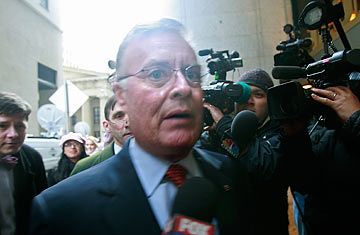
Ken Lewis prepares to enter the offices of New York attorney general Andrew Cuomo in New York City
Last December at a black-tie industry gala in New York City's famed Plaza Hotel, Ken Lewis strode past other top financial executives to the podium to accept the award for Banker of the Year. The financial industry was crashing, but Lewis looked to be at the top of his game. The CEO told the crowd, "It is incumbent upon all of us, especially those of us whose performance has left us in a strengthened leadership position, to help our industry find a new balance between our desire for economic growth and our need for market stability."
This December, Lewis will be out of a job. On Wednesday, he sent an e-mail to the bank's staffers saying he will retire by the end of the year. Lewis, 62, said it was his decision to leave, but no one could miss the huge legal dustup swirling around him over the bank's deal late last year to buy Merrill Lynch. The Securities and Exchange Commission (SEC) and New York attorney general Andrew Cuomo have been investigating whether Lewis misled shareholders to gain approval of that acquisition. He could soon face charges in those probes.
Bank of America said a replacement for Lewis has yet to be named.
The financial meltdown has claimed the careers of many banking-industry stars. But no executive has had as big a roller-coaster ride during this crisis as Lewis. At its start, Lewis and Bank of America looked to benefit from the turmoil facing the banking business. The firm, based in Charlotte, N.C., had never been a big player in the subprime-mortgage business, in either lending or underwriting loans. That prudence led to smaller lending losses at B of A than at Citigroup and other rivals. What's more, while other financial firms were verging on broke, Bank of America seemed to have enough capital to play the role of rescuer in the credit crunch.
On the weekend before Lehman Brothers' collapse, Merrill Lynch CEO John Thain turned to Lewis for help. Thain called Lewis to offer him 10% of his firm. Lewis said he wanted it all. By the end of the weekend, the deal was done. Lewis was hailed as a hero for saving Merrill on the same morning that Lehman was forced to file for bankruptcy.
Son of an Army sergeant and a nurse, Lewis grew up in Columbus, Ga. He joined the firm that would become Bank of America right after graduating from George State College in 1969. Early on, Lewis' cool demeanor and keen credit judgment caught the eye of the bank's chief executive, Hugh McColl. Soon Lewis became the wingman to McColl's swashbuckling merger ways. McColl would do the deals, and Lewis would parachute in to do the cost-cutting and integration. Along the way, the two built Bank of America to become the country's largest bank in terms of deposits.
When McColl retired in 2001, Lewis took over. But rather than retrenching as most people expected, Lewis proved he liked the art of the deal as much as McColl. In 2003, Bank of America bought Boston-based bank Fleet for $47 billion. Two years later he spent $35 billion to buy credit card giant MBNA. And as the credit crisis began to unfold, Lewis picked up Countrywide, which at its height was the nation's largest independent mortgage lender, for just over $4 billion.
Lewis had long coveted the retail brokerage business. Merrill Lynch, with its legions of investment salespeople, was to be Lewis' crowning acquisition. It ended up being his undoing. In the quickly hatched deal, Lewis paid $19 billion for Merrill, which most people agreed was nearly bankrupt. In the fourth quarter alone, Merrill Lynch lost more than $15 billion.
